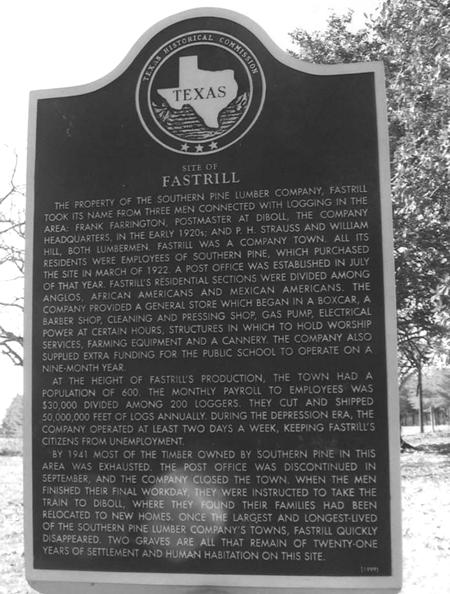Fastrill Texas, an old logging camp in Cherokee County. (original) (raw)
Some time in the distant future, if Dallas has its way, a new reservoir could be built on the Neches River in Cherokee and Anderson County.
If the proposal ever becomes reality, the lake would inundate a landmark in the history of the forest products history--an old logging camp known as Fastrill.
There were hundreds of logging camps in early East Texas, but few achieved the homely nobility of Fastrill, which was established in 1922 as a logging base for Diboll�s Southern Pine Lumber Company.

A Texas State Historical Marker at Fastrill
Photo courtesy Bob Bowman
The town got its name from a combination of three names: FA from F.F. Farrington, a former Diboll postmaster; STR from P.H. Strauss, who was in charge of Southern Pine�s logging camps; and ILL from Will Hill, the company�s woods foreman.
The town stood near a bend in the Neches River about 15 miles west of Alto. Of all the Southern Pine logging camps, Fastrill is best-remembered by the company�s old timers. At its peak the community had a four-teacher school, two churches, a post office, commissary store, boarding house, a voting precinct and a population approaching 600.
�Fastrill was as pretty a logging camp as a person went into,� said Wesley Ashworth, a carpenter and repairman for Southern Pine. �It had wide, long streets, sycamore trees up and down the streets, and stood on a sandy hill, a beautiful place.�
Southern Pine operated dozens of logging camps--sometimes called �front camps,�--in places like Alceda, White City, Buff City, Lindsey Springs, Walkerton, Neff, Hull, Gilbert, Buggerville, Gipson, and Apple Springs.
�I suppose Fastrill is remembered so well because it was a big camp, the most permanent camp, and was in existence longer than any other camp the company had,� said Vina Wells, whose family moved there from White City in 1922.
Today, little is left of Fastrill, but some of the town�s former residents return regularly to its site to wander through the forest, dig up old railroad spikes, and read a Texas State Historical Marker placed there years ago.
April 4, 2009 Column.
A weekly column syndicated in 70 East Texas newspapers
Texas Escapes, in its purpose to preserve historic, endangered and vanishing Texas, asks that anyone wishing to share their local history, stories, landmarks and vintage or recent photos, please contact us.